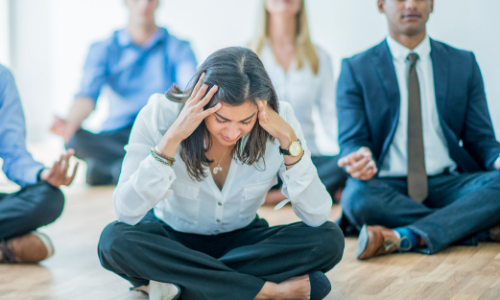Stress At Work: Try These Simple Relaxation Techniques From Yoga
This article was written by: Bene Spoelders, Yoga Instructor at Body Mechanics
When you feel stressed with work pressure, you feel in a constant state of alertness: your mind is focused on your job even after work hours and you wake up during the night worrying about your colleagues or deadlines. You know that you have managed similar and even worse pressures in the past, but you can’t stop your mind from racing and worrying. In this article, I briefly talk about stress at work and how it can impact your productivity and happiness, and why clever companies offer wellness programmes to their employees. I finish by giving you 3 simple practices that you can do right now to combat stress.
Fight or flight
Stress at work, financial worries, and emotional unrest can all be sources of stress that send your body into the ‘fight or flight’ mode. This is a useful state of mind sometimes, when you have to perform under pressure, but not when it becomes chronic. Chronic stress leads to a permanently increased heart rate, increased blood pressure, digestive problems, shallow breathing, a scattered mind, and anxiety. The problem is that we are often unaware of being in this heightened state of worry and alertness.
Relaxation response
Chronic stress is the cause of many health problems, such as heart disease, high blood pressure, back pain, digestive disorders, a weakened immune system, etc. It is important to include activities in our daily lives that will counteract this chronic state of alertness. Dr. Herbert Benson used the term “relaxation response” to describe the state of recuperation after the fight or flight mode. To promote the relaxation response, he says we only need “10 to 20 minutes in a calm environment, a focus for the mind, and a passive (non-judgmental) attitude”.
Interestingly, doing yoga fulfils these criteria: it happens in a calm environment, focuses the mind and the aim is not to judge or compare one’s performance. Doing physical postures with awareness, concentrating on the body and the breath, allows the “fight or flight mode” to change into the “relaxation response”. As yoga students, we often start a yoga session with a racing and troubled mind, sometimes without even realising the tensions. Amazingly, we leave the class feeling calmer, content and more clear-headed. It is not that we have tackled the problems head-on; on the contrary, the only thing we have done is paid attention to our body.
Yoga for the workplace
It is no surprise that offering yoga classes at the workplace is increasingly popular. Research has repeatedly proven that yoga classes can be an efficient and cost-effective part of a company’s corporate wellness programme. The University of Michigan Research Centre found in 2010 that for every $1 invested in workplace wellness, a company can expect at least double in cost savings.
The benefits of doing yoga for employees include not only physical ones such as improved back health, reduced neck, and shoulder tension, and optimized breathing but also mental benefits such as reduced anxiety and stress, greater focus and concentration, and reduced fatigue. All these lead to increased efficiency at work and greater job satisfaction.
The gains for employers are an enriched corporate culture, reduced sickness and absenteeism, increased productivity, and increased employee retention.
Try this…
Maybe your workplace does not offer yoga classes yet, so today I would like to share 3 exercises that can promote your body’s relaxation response. I purposely chose practices that don’t require a lot of time and that you can incorporate in daily activities: one simple movement, one way of mindful walking, and one breathing exercise. You will get the best results if you practise these every day.
1. Feet, breath, and focus:
Do this preferably in bare feet, but you can also do it in shoes when you are alone in a lift or waiting for the bus.
- Inhale and lift your heels so you come to stand on the balls of your feet.
- Exhale and slowly bring the heels down.
- Repeat for about a minute, paying attention to the coordination of breath and movement. This means that you use the whole inhalation to lift the heels and the heels only touch the ground again at the very end of the exhalation.
- Make sure you keep the weight behind all the toes, and not only behind the big toe or little toe, which can be detrimental to the strength and stability of your ankles.
- Once you have mastered the weight distribution and slow coordination of movement and breath, add the arm movement: bring your arms to the side and up to shoulder height as you rise onto the toes, lower them with the exhalation. This movement promotes calm, expands the chest, and strengthens the feet.
As always with yoga: don’t do it if it hurts.
2. Mindful walking:
While walking, consciously observe your surroundings: sounds, smell, colours, shapes, light, and shade. As soon as you catch yourself thinking of other things, bring your attention back to your surroundings. Try to practise this every time you walk. This is an interesting practice: it demonstrates how little we normally notice in our surroundings and how entertaining they usually are.
3. Breathing to promote the relaxation response:
At your desk and need a little pause?
- Close your eyes or gaze at something non-specific and breathe in for 4 counts, out for 6 counts. It does not matter how fast or slow the counting is, just keep the ratio between the in- and out-breath.
- While breathing like this, feel your body relax on the chair, keeping the front and back of the body long and broad.
- Continue for at least a minute.
This breathing exercise is not only relaxing, but it will also allow you to take a step back from what you were just doing, giving you greater peace and clarity.

